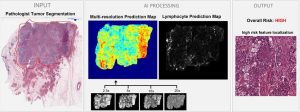AI Accurately Differentiates Cancer Cells from Normal Cells
Researchers have recently developed artificial intelligence (AI) that can accurately differentiate between cancerous and normal cells. This breakthrough not only offers significant promise for cancer diagnosis and treatment but also provides hope for earlier detection and more personalized therapies.
The Role of AI in Modern Medicine
In recent years, AI has made a substantial impact across various sectors, particularly in healthcare. By employing complex algorithms and analyzing vast datasets, AI systems can evaluate medical images and data far beyond human capabilities. Consequently, this ability proves especially beneficial in oncology, where early and accurate cancer detection can significantly improve patient outcomes.

How AI Differentiates Between Cells
The process begins when researchers feed the AI system a large collection of images containing both cancerous and normal cells. Through machine learning, the AI identifies patterns and features that distinguish the two types of cells. Over time, the system learns to recognize even the subtlest differences that might escape the human eye.
For instance, in a recent study, scientists trained an AI program using thousands of cell images. They then tested the system on new images, and it successfully identified cancerous cells with over 90% accuracy. This level of precision highlights AI’s potential to revolutionize cancer diagnostics.
Real-World Applications and Benefits
This technology carries profound implications for patient care. In clinical settings, AI can assist pathologists by providing a second opinion, which reduces the chances of misdiagnosis. Moreover, in areas with limited access to medical professionals, AI can serve as a crucial tool for early cancer detection.
For example, imagine a patient undergoing a biopsy. Traditionally, a pathologist examines the tissue sample under a microscope, a process that can take time and involves subjective judgment. However, with AI, the same sample can undergo quick and accurate analysis, delivering results that guide immediate treatment decisions.

Challenges and Future Directions
Despite its promise, integrating AI into healthcare presents several challenges. One major concern involves the need for extensive datasets to train AI models effectively. Additionally, ethical considerations regarding data privacy and the potential for AI to replace human jobs continue to arise.
Nevertheless, researchers remain optimistic about the future. Ongoing advancements in technology and data security pave the way for more robust and secure AI applications. As AI continues to evolve, its role in healthcare is expected to expand, offering new possibilities for patient care and treatment.
Conclusion
In conclusion, the ability of AI to distinguish between cancerous and normal cells marks a significant milestone in medical technology. By enhancing diagnostic accuracy and speed, AI transforms cancer care, leading to better patient outcomes and more efficient healthcare systems. As we look to the future, continued collaboration between technology and medicine promises to unlock even greater innovations, ultimately improving the quality of life for countless individuals worldwide.

